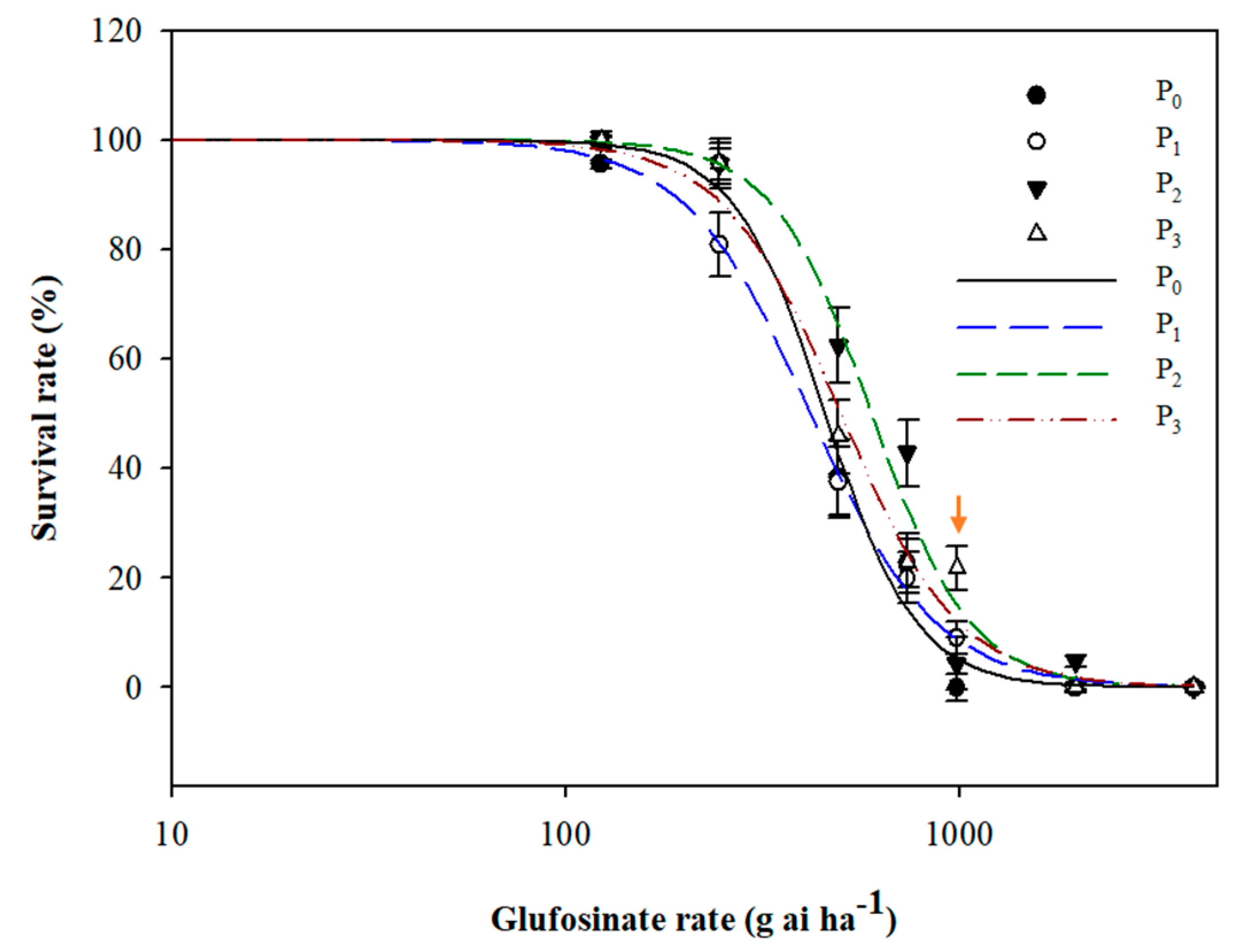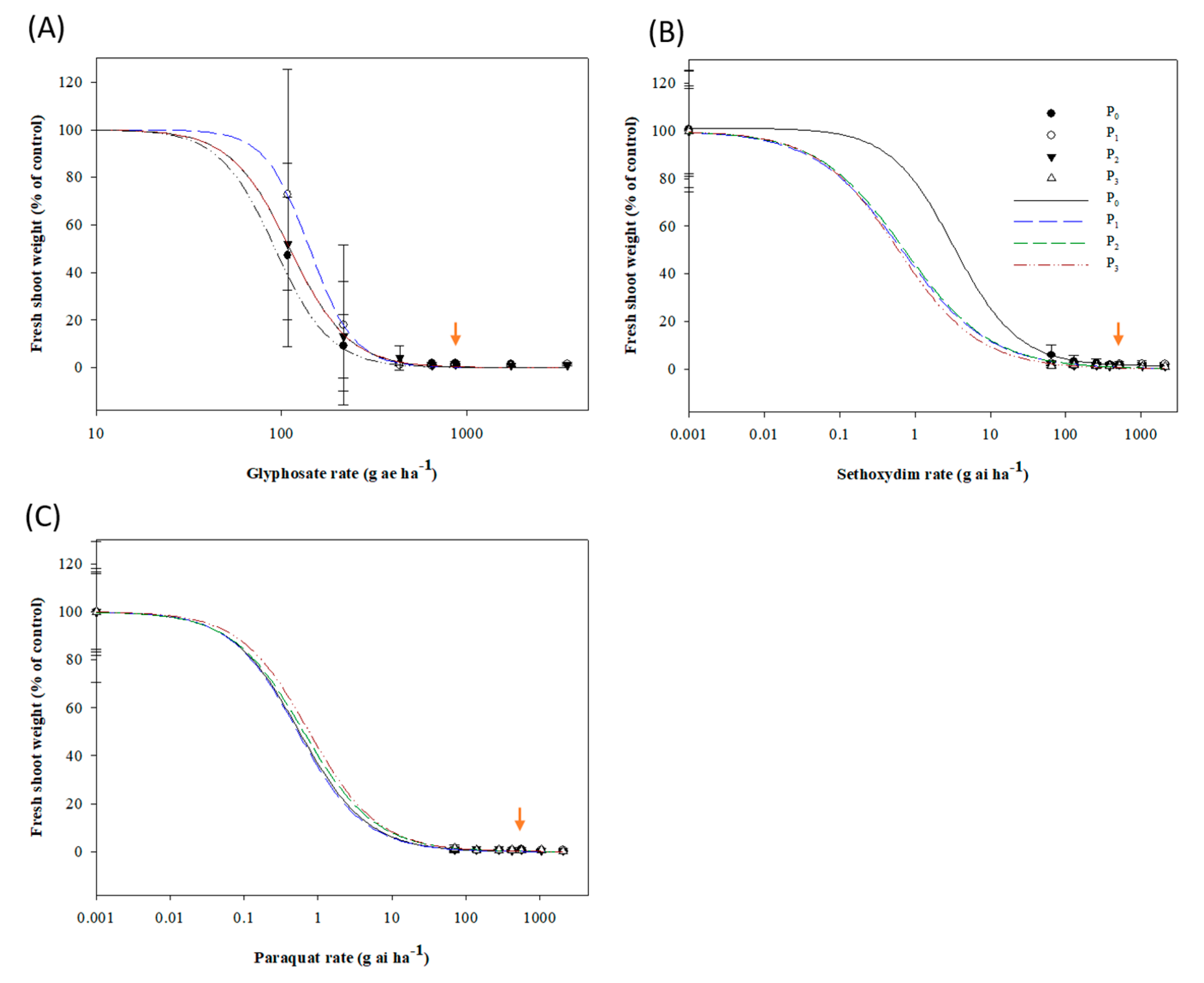Recurrent Selection with Glufosinate at Low Rates Reduces the Susceptibility of a Lolium perenne ssp. multiflorum Population to Glufosinate
Abstract
1. Introduction
2. Materials and Methods
2.1. Plant Material
2.2. Recurrent Selection with Glufosinate at Low Rates
2.3. Dose–Response of the Parental and Selected Populations to Glufosinate
2.4. Cross-Resistance to Glyphosate, Paraquat, and Sethoxydim
2.5. Statistical Analyses
3. Results and Discussion
3.1. Recurrent Selection with Glufosinate at Low Rates
3.2. Dose–Response of Parental and Selected Populations to Glufosinate and Other Herbicides
3.3. Cross-Resistance to Glyphosate, Paraquat, and Sethoxydim
Author Contributions
Funding
Acknowledgments
Conflicts of Interest
References
- Oerke, E.C. Crop losses to pests. J. Agric. Sci. 2006, 144, 31–43. [Google Scholar] [CrossRef]
- Powles, S.B.; Yu, Q. Evolution in action: Plants resistant to herbicides. Annu. Rev. Plant Biol. 2010, 61, 317–347. [Google Scholar] [CrossRef]
- Délye, C.; Jasieniuk, M.; Le Corre, V. Deciphering the evolution of herbicide resistance in weeds. Trends Genet. 2013, 29, 649–658. [Google Scholar] [CrossRef] [PubMed]
- Gressel, J. Low pesticide rates may hasten the evolution of resistance by increasing mutation frequencies. Pest Manag. Sci. 2011, 67, 253–257. [Google Scholar] [CrossRef] [PubMed]
- Tehranchian, P.; Norsworthy, J.K.; Powles, S.; Bararpour, M.T.; Bagavathiannan, M.V.; Barber, T.; Scott, R.C. Recurrent sublethal-dose selection for reduced susceptibility of palmer amaranth (Amaranthus palmeri) to dicamba. Weed Sci. 2017, 65, 206–212. [Google Scholar] [CrossRef]
- Norsworthy, J.K. Repeated sublethal rates of glyphosate lead to decreased sensitivity in palmer amaranth. Crop Manag. 2012, 11, 1–6. [Google Scholar] [CrossRef]
- Neve, P.; Powles, S. Recurrent selection with reduced herbicide rates results in the rapid evolution of herbicide resistance in Lolium rigidum. Theor. Appl. Genet. 2005, 110, 1154–1166. [Google Scholar] [CrossRef]
- Busi, R.; Gaines, T.A.; Walsh, M.J.; Powles, S.B. Understanding the potential for resistance evolution to the new herbicide pyroxasulfone: Field selection at high doses versus recurrent selection at low doses. Weed Res. 2012, 52, 489–499. [Google Scholar] [CrossRef]
- Busi, R.; Girotto, M.; Powles, S.B. Response to low-dose herbicide selection in self-pollinated Avena Fatua. Pest Manag. Sci. 2016, 72, 603–608. [Google Scholar] [CrossRef]
- DiTomaso, J.M.; Healy, E.A. Weeds of California and other Western States. In California Division of Agriculture and Natural Resources; University of California Division of Agriculture and Natural Resources publication: Oakland, CA, USA, 2007; Volume 2, pp. 1195–1200. ISBN 1879906694. [Google Scholar]
- Jasieniuk, M.; Ahmad, R.; Sherwood, A.M.; Firestone, J.L.; Perez-Jones, A.; Lanini, W.T.; Mallory-Smith, C.; Stednick, Z. Glyphosate-resistant Italian ryegrass (Lolium multiflorum) in California: Distribution, response to glyphosate, and molecular evidence for an altered target enzyme. Weed Sci. 2008, 56, 496–502. [Google Scholar] [CrossRef]
- Brunharo, C.A.C.G.; Hanson, B.D. Vacuolar sequestration of paraquat is involved in the resistance mechanism in Lolium perenne L. spp. multiflorum. Front. Plant Sci. 2017, 8, 1485. [Google Scholar] [CrossRef] [PubMed]
- Karn, E.; Beffa, R.; Jasieniuk, M. Variation in response and resistance to glyphosate and glufosinate in California populations of Italian ryegrass (Lolium perenne ssp. multiflorum). Weed Sci. 2018, 66, 168–179. [Google Scholar] [CrossRef]
- Tehranchian, P.; Nandula, V.; Jugulam, M.; Putta, K.; Jasieniuk, M. Multiple resistance to glyphosate, paraquat and ACCase-inhibiting herbicides in Italian ryegrass populations from California: Confirmation and mechanisms of resistance Parsa Tehranchian. Pest Manag. Sci. 2018, 74, 868–877. [Google Scholar] [CrossRef] [PubMed]
- Tehranchian, P.; Nandula, V.K.; Matzrafi, M.; Jasieniuk, M. Multiple herbicide resistance in California Italian ryegrass (Lolium perenne ssp. multiflorum): Characterization of ALS-inhibiting herbicide resistance. Weed Sci. 2019, 67, 273–280. [Google Scholar] [CrossRef]
- Simarmata, M.; Kaufmann, J.E.; Penner, D. Potential basis of glyphosate resistance in California rigid ryegrass (Lolium rigidum). Weed Sci. 2003, 51, 678–682. [Google Scholar] [CrossRef]
- Heap, I. The International Survey of Herbicide Resistant Weeds. Available online: http://www.weedscience.com (accessed on 5 July 2020).
- Avila-Garcia, W.V.; Sanchez-Olguin, E.; Hulting, A.G.; Mallory-Smith, C. Target-site mutation associated with glufosinate resistance in Italian ryegrass (Lolium perenne L. ssp. multiflorum). Pest Manag. Sci. 2012, 68, 1248–1254. [Google Scholar] [CrossRef]
- Avila-Garcia, W.V.; Mallory-Smith, C. Glyphosate-resistant Italian ryegrass (Lolium perenne) populations also exhibit resistance to glufosinate. Weed Sci. 2011, 59, 305–309. [Google Scholar] [CrossRef]
- Development Core Team [R 2010]. R: A Language and Environment for Statistical Computing; R Foundation for Statistical Computing: Vienna, Austria; ISBN 3-900051-07-0. Available online: http://www.R-project.org (accessed on 2 July 2020).
- Seefeldt, S.S.; Jensen, J.E.; Fuerst, E.P. Feature log-logistic analysis of herbicide dose-response relationships. Weed Technol. 1995, 9, 218–227. [Google Scholar] [CrossRef]
- Busi, R.; Neve, P.; Powles, S. Evolved polygenic herbicide resistance in Lolium rigidum by low-dose herbicide selection within standing genetic variation. Evol. Appl. 2013, 6, 231–242. [Google Scholar] [CrossRef]
- Yu, Q.; Han, H.; Cawthray, G.R.; Wang, S.F.; Powles, S.B. Enhanced rates of herbicide metabolism in low herbicide-dose selected resistant Lolium rigidum. Plant. Cell Environ. 2013, 36, 818–827. [Google Scholar] [CrossRef]
- Ashworth, M.B.; Walsh, M.J.; Flower, K.C.; Powles, S.B. Recurrent selection with reduced 2,4-D amine doses results in the rapid evolution of 2,4-D herbicide resistance in wild radish (Raphanus raphanistrum L.). Pest Manag. Sci. 2016, 72, 2091–2098. [Google Scholar] [CrossRef] [PubMed]
- Kumaratilake, A.R.; Preston, C. Low temperature reduces glufosinate activity and translocation in wild radish (Raphanus raphanistrum). Weed Sci. 2005, 53, 10–16. [Google Scholar] [CrossRef]
- Coetzer, E.; Al-Khatib, K.; Loughin, T.M. Glufosinate efficacy, absorption, and translocation in amaranth as affected by relative humidity and temperature. Weed Sci. 2001, 49, 8–13. [Google Scholar] [CrossRef]


| Population | Glufosinate Rate (g·ai·ha−1) | Seedling Treated (n) | Survivors (%) |
|---|---|---|---|
| Parental (P0) | 123 (0.125X) | 200 | 100 |
| 246 (0.25X) | 200 | 90.5 | |
| 492 (0.5X) | 200 | 23.5 | |
| P1 | 492 (0.5X) | 300 | 71 |
| 738 (0.75X) | 300 | 21 | |
| 984 (1X) | 300 | 5 | |
| P2 | 738 (0.75X) | 300 | 33 |
| 984 (1X) | 300 | 12 | |
| 1230 (1.25X) | 300 | 7 |
| Population | a LD50 (g·ai/ae·ha−1) | SE d | RI e (Pn/P0) | SE RI |
|---|---|---|---|---|
| P0 | 452.39 (382.77–522.02) c | 35.52 | - | 0.11 |
| P1 | 429.95 (351.98–507.93) | 39.78 | 0.95 | 0.11 |
| P2 | 592.08 (502.46–681.7) | 45.72 | 1.31 | 0.14 |
| P3 | 529.2 (444.75–613.65) | 43.08 | 1.16 | 0.13 |
| b LD90 (g·ai/a·ha−1) | SE | RI (Pn/P0) | SE RI | |
| P0 | 817.66 (640.4–994.92) | 90.44 | - | 0.15 |
| P1 | 888.82 (656.12–1121.5) | 118.72 | 1.08 | 0.18 |
| P2 | 1117.58 (839.05–1396.1) | 142.10 | 1.36 | 0.23 |
| P3 | 1038.16 (782.07–1294.3) | 130.66 | 1.26 | 0.21 |
| % Survivors at Each Herbicide Rate | |||||||||
|---|---|---|---|---|---|---|---|---|---|
| Population | 0 | 0.125 | 0.25 | 0.5 | 0.75 | 1 | 2 | 4 | |
| Glyphosate | P0 | 100 | 100 | 45 | 0 | 0 | 0 | 0 | 0 |
| P1 | 100 | 100 | 20 | 0 | 0 | 0 | 0 | 0 | |
| P2 | 100 | 100 | 20 | 20 | 0 | 0 | 0 | 0 | |
| P3 | 100 | 80 | 20 | 20 | 0 | 0 | 0 | 0 | |
| Paraquat | P0 | 100 | 0 | 0 | 0 | 0 | 0 | 0 | 0 |
| P1 | 100 | 10 | 0 | 0 | 0 | 0 | 0 | 0 | |
| P2 | 100 | 0 | 0 | 0 | 0 | 0 | 0 | 0 | |
| P3 | 100 | 20 | 0 | 0 | 0 | 0 | 0 | 0 | |
| Sethoxydim | P0 | 100 | 10 | 10 | 0 | 0 | 0 | 0 | 0 |
| P1 | 100 | 0 | 0 | 0 | 0 | 0 | 0 | 0 | |
| P2 | 100 | 0 | 0 | 0 | 0 | 0 | 0 | 0 | |
| P3 | 100 | 10 | 0 | 0 | 0 | 0 | 0 | 0 | |
© 2020 by the authors. Licensee MDPI, Basel, Switzerland. This article is an open access article distributed under the terms and conditions of the Creative Commons Attribution (CC BY) license (http://creativecommons.org/licenses/by/4.0/).
Share and Cite
Matzrafi, M.; Morran, S.; Jasieniuk, M. Recurrent Selection with Glufosinate at Low Rates Reduces the Susceptibility of a Lolium perenne ssp. multiflorum Population to Glufosinate. Agronomy 2020, 10, 1288. https://doi.org/10.3390/agronomy10091288
Matzrafi M, Morran S, Jasieniuk M. Recurrent Selection with Glufosinate at Low Rates Reduces the Susceptibility of a Lolium perenne ssp. multiflorum Population to Glufosinate. Agronomy. 2020; 10(9):1288. https://doi.org/10.3390/agronomy10091288
Chicago/Turabian StyleMatzrafi, Maor, Sarah Morran, and Marie Jasieniuk. 2020. "Recurrent Selection with Glufosinate at Low Rates Reduces the Susceptibility of a Lolium perenne ssp. multiflorum Population to Glufosinate" Agronomy 10, no. 9: 1288. https://doi.org/10.3390/agronomy10091288
APA StyleMatzrafi, M., Morran, S., & Jasieniuk, M. (2020). Recurrent Selection with Glufosinate at Low Rates Reduces the Susceptibility of a Lolium perenne ssp. multiflorum Population to Glufosinate. Agronomy, 10(9), 1288. https://doi.org/10.3390/agronomy10091288





